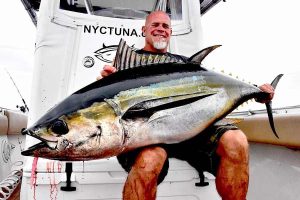Captain John McMurray, known for his expertise in offshore fishing, has gained a reputation for eschewing the traditional trolling method in favor of a more engaging light-tackle approach. Unlike many skippers who troll for big fish, McMurray and his crew prefer to jig and pop for large fish like bluefin tuna, using lighter gear that brings a heightened sense of excitement and challenge to the experience.
The Early Years and the Offshore Bug
McMurray’s passion for light-tackle fishing traces back to his youth, casting topwater plugs for largemouth bass. The thrill of a bass striking a lure was something he never outgrew, and this excitement translated seamlessly into his later pursuit of striped bass, known for their aggressive strikes. However, as the summer heat dulled the striped bass’ activity, McMurray sought new challenges, leading him offshore.
In 2005, a run of schoolie bluefin tuna off New Jersey’s Ambrose Light region sparked McMurray’s fascination with offshore fishing. The experience was transformative, leading to the purchase of his first offshore-capable boat—a 25-foot Contender. Initially, McMurray fell into the conventional belief that trolling was the only way to catch tuna, investing heavily in trolling setups. However, a disastrous first outing led to a revelation: the real excitement and success lay in jigging and popping. From that point on, trolling gear was abandoned, and the pursuit of tuna took on a new, more exhilarating form.

The Thrill of Jigging and Popping
For McMurray, trolling diminishes the most thrilling aspects of tuna fishing. The heart-pounding moment when a jig stops mid-drop, signaling a strike, or the explosive surface strike on a popper, is where the true excitement lies. This active hunt, free from the constraints of heavy gear, offers an unparalleled battle with these powerful fish. The use of light tackle intensifies the experience, making every catch a test of skill and endurance.
Gear and Tactics for Tuna Fishing
Today’s tuna fishing gear has evolved significantly, with spinning setups now robust enough to handle the pressure of big fish. McMurray favors short, soft jigging rods like those from Centaur, paired with resilient offshore reels such as the Daiwa Saltiga and Shimano Stella. These rods and reels are designed to handle the rigors of tuna fishing, allowing anglers to jig or pop all day without fatigue.
For topwater fishing, McMurray recommends the Madd Mantis Cherry Pop, particularly in the Frostbite color, for its ability to push water and entice strikes. When it comes to jigs, the Nomad Streaker, especially in PinkGlo, has proven effective, with different weights used depending on conditions.
Braided line, such as Cortland’s hollow-core braid for popping and Daiwa Saltiga Boat Braid for jigging, is essential for maximizing line capacity and strength. The use of fluorocarbon leader material and strong terminal tackle, like 200-pound Spro swivels and split rings, ensures that the gear can withstand the force of a battling tuna.

Finding the Fish
Success in tuna fishing often comes down to finding life in the water. McMurray emphasizes the importance of locating marine activity, such as whales, porpoises, or birds like storm petrels and shearwaters, which often indicate the presence of tuna. He also notes that while temperature breaks can be a factor, the key is to follow the bait, particularly sand eels, which are a primary food source for both yellowfin and bluefin tuna.
Avoiding crowded trolling areas and finding isolated pockets of activity can lead to better fishing opportunities. McMurray advises keeping an eye on the sounder, but also trusting that tuna may be present even if they aren’t marked directly under the boat.
For those seeking the ultimate tuna fishing experience, McMurray’s approach offers a more dynamic and rewarding alternative to traditional trolling. By embracing the challenge of jigging and popping with light tackle, anglers can engage in an active hunt that tests their skills and delivers an unforgettable rush.
Image/Source: gameandfishmag





